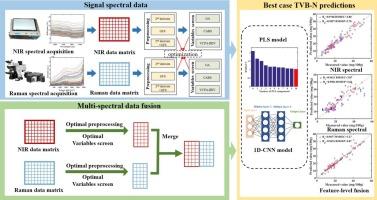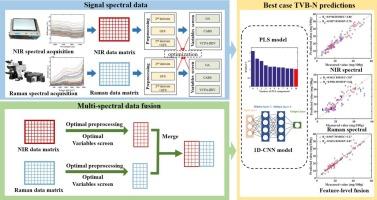Analyzing TVB-N in snakehead by Bayesian-optimized 1D-CNN using molecular vibrational spectroscopic techniques: Near-infrared and Raman spectroscopy
IF 9.8
1区 农林科学
Q1 CHEMISTRY, APPLIED
引用次数: 0
Abstract
Total volatile basic nitrogen (TVB-N) is one of the key indicators for assessing fish freshness. This research employed near-infrared (NIR) and Raman spectroscopy methods to detect the TVB-N content in snakehead fillets. We extracted feature variables associated with TVB-N from NIR and Raman spectroscopy using Variable Crossover Point Arithmetic - Improved Reduced-Input Vector (VCPA-IRIV). Using these features, we established partial least squares (PLS) and One-dimensional Convolutional Neural Network (1D-CNN) models. Subsequently, data fusion strategies were employed to predict the TVB-N content. Notably, feature-level fusion in conjunction with Bayesian-optimized 1D-CNN, reached the best results, as evidenced by calibration and predictive correlation coefficients of 0.9677 and 0.9676 for TVB-N. These findings underscore the effectiveness of both NIR and Raman spectroscopy in evaluating fish freshness. The fusion of these two vibrational spectroscopy techniques enables a more rapid, efficient and comprehensive quantification of fish freshness.


利用分子振动光谱技术,通过贝叶斯优化的 1D-CNN 分析乌鳢的 TVB-N:近红外光谱和拉曼光谱
总挥发性碱基氮(TVB-N)是评估鱼类新鲜度的关键指标之一。本研究采用近红外(NIR)和拉曼光谱方法检测乌鳢鱼片中的 TVB-N 含量。我们利用可变交叉点算术-改进的还原输入向量(VCPA-IRIV)从近红外光谱和拉曼光谱中提取了与 TVB-N 相关的特征变量。利用这些特征,我们建立了偏最小二乘法(PLS)和一维卷积神经网络(1D-CNN)模型。随后,我们采用数据融合策略来预测 TVB-N 的内容。值得注意的是,结合贝叶斯优化的一维卷积神经网络的特征级融合达到了最佳效果,TVB-N 的校准和预测相关系数分别为 0.9677 和 0.9676。这些发现强调了近红外光谱和拉曼光谱在评估鱼类新鲜度方面的有效性。这两种振动光谱技术的融合可以更快速、高效、全面地量化鱼的新鲜度。
本文章由计算机程序翻译,如有差异,请以英文原文为准。
求助全文
约1分钟内获得全文
求助全文
来源期刊

Food Chemistry
工程技术-食品科技
CiteScore
16.30
自引率
10.20%
发文量
3130
审稿时长
122 days
期刊介绍:
Food Chemistry publishes original research papers dealing with the advancement of the chemistry and biochemistry of foods or the analytical methods/ approach used. All papers should focus on the novelty of the research carried out.
文献相关原料
公司名称
产品信息
百灵威
magnesium oxide
¥18.00~¥48886.00
百灵威
bromocresol green
¥17.00~¥8712.00
百灵威
methyl red
¥21.00~¥8064.00
 求助内容:
求助内容: 应助结果提醒方式:
应助结果提醒方式:


